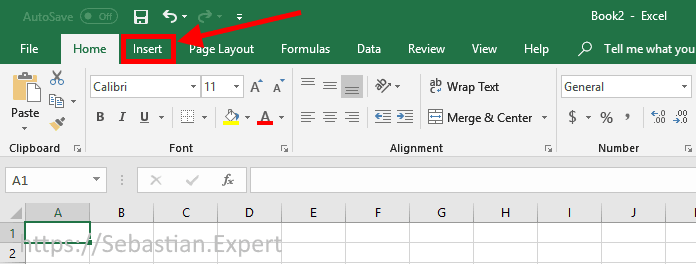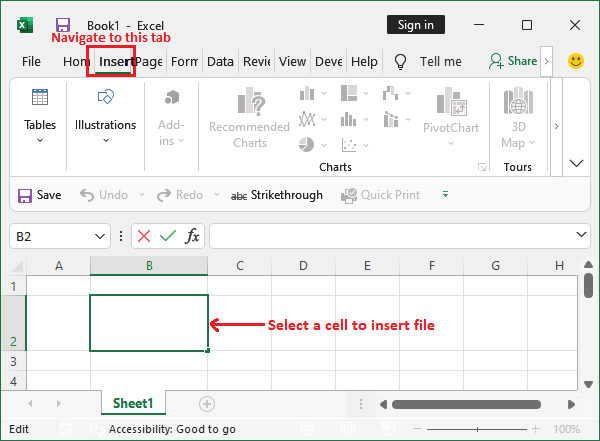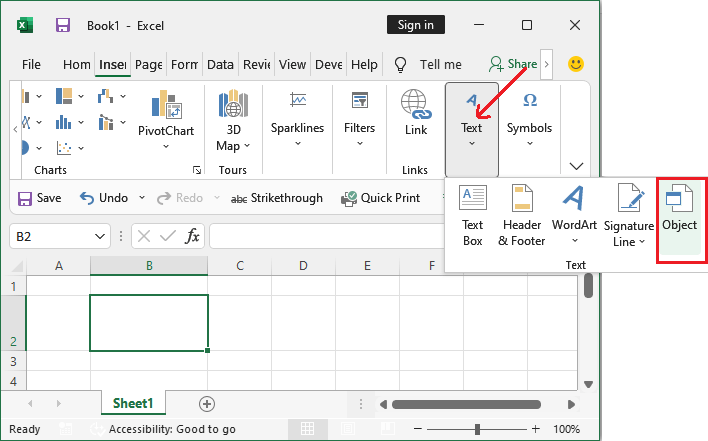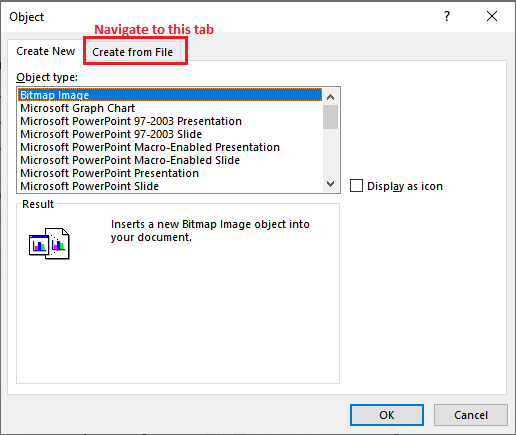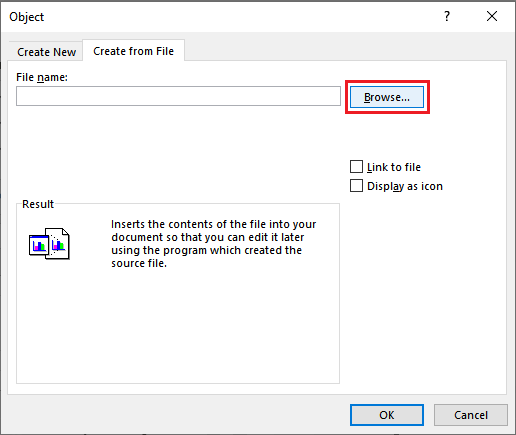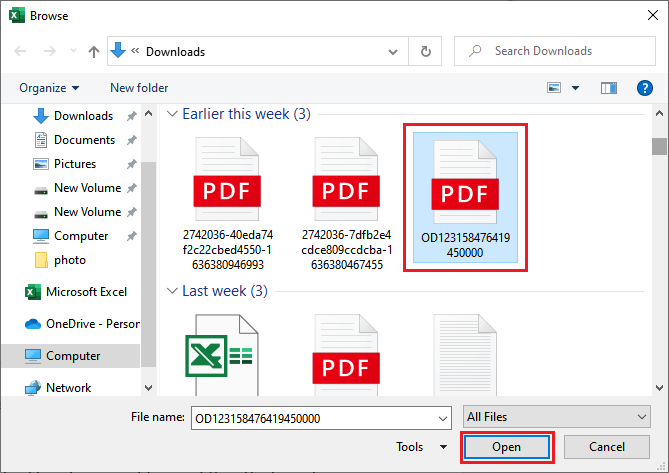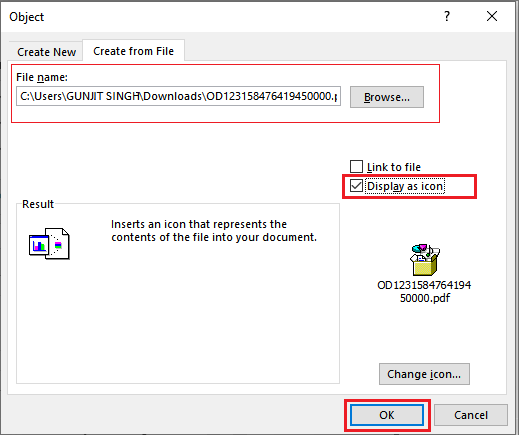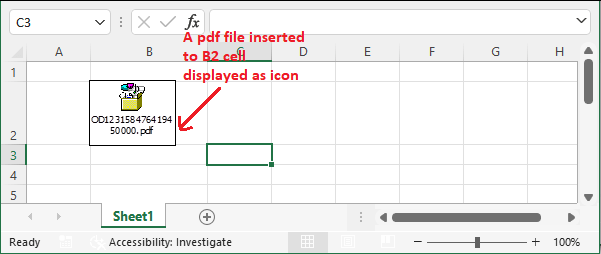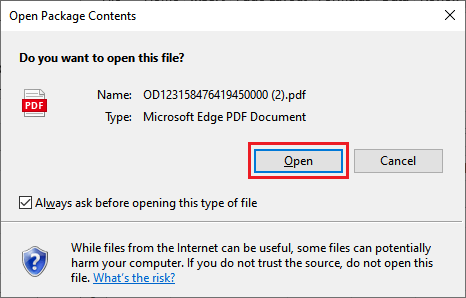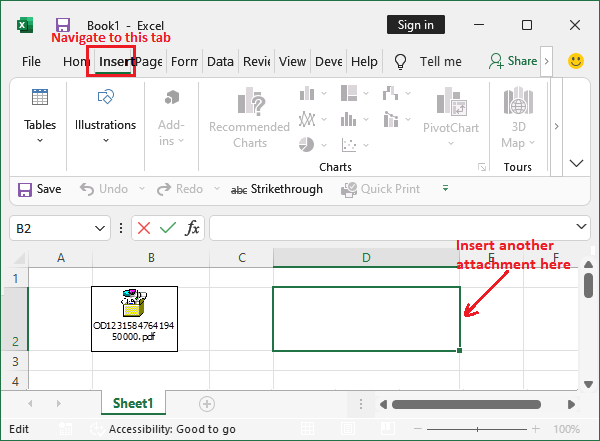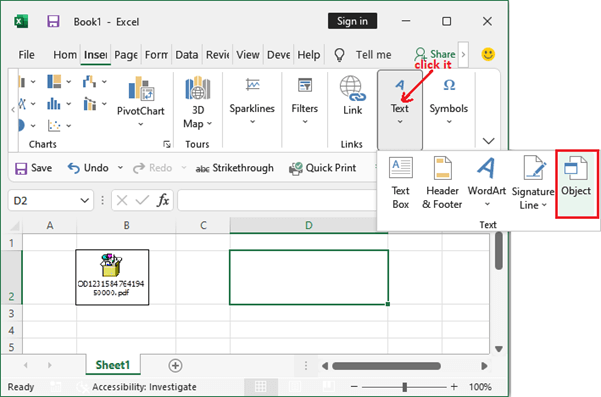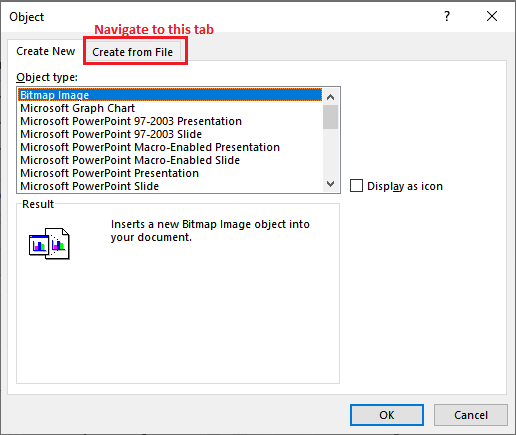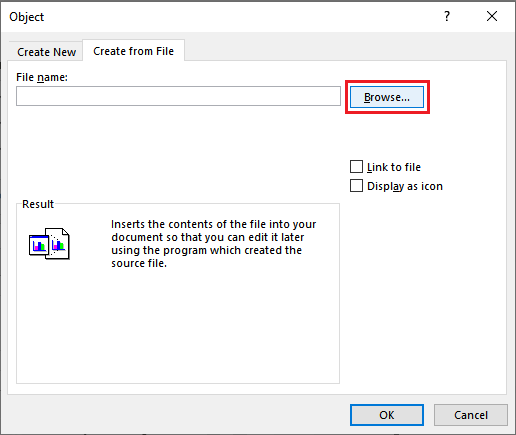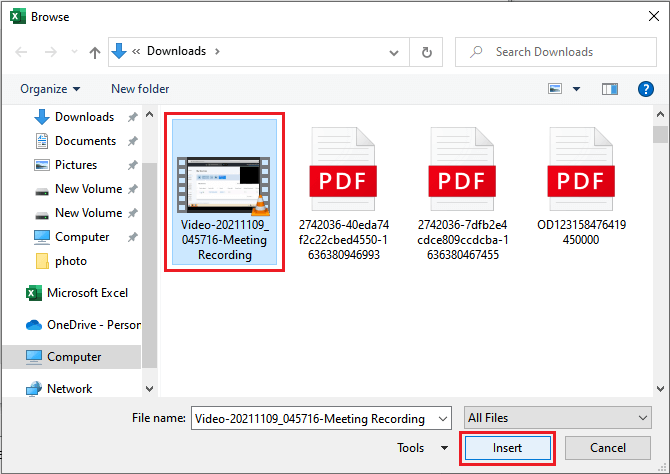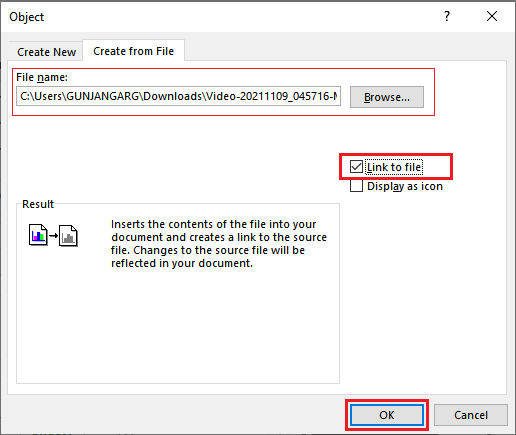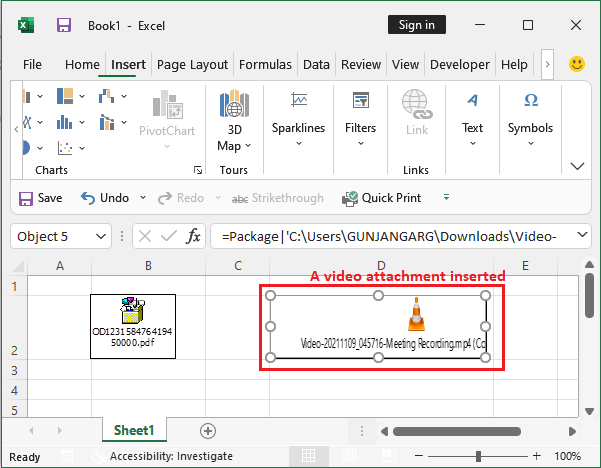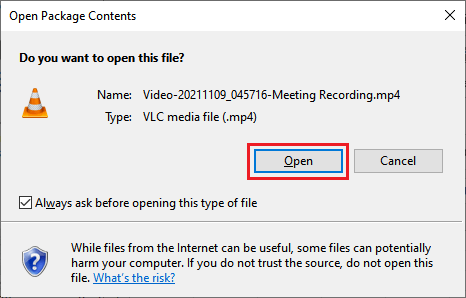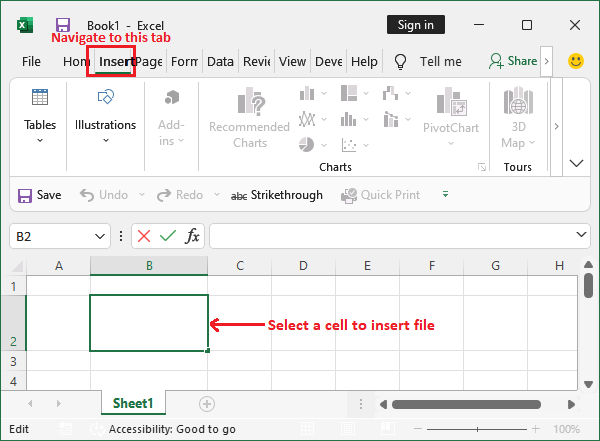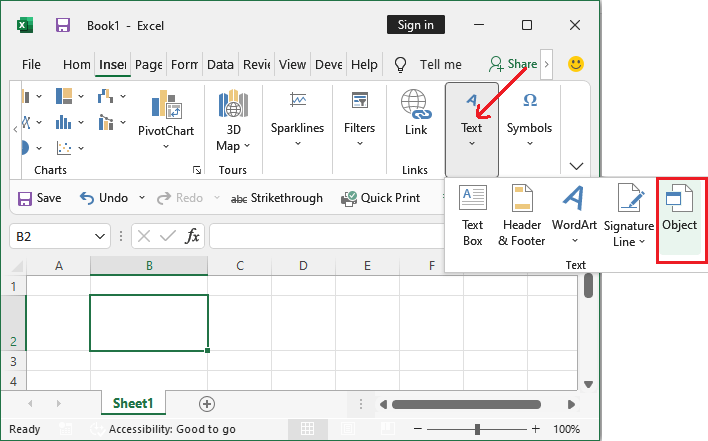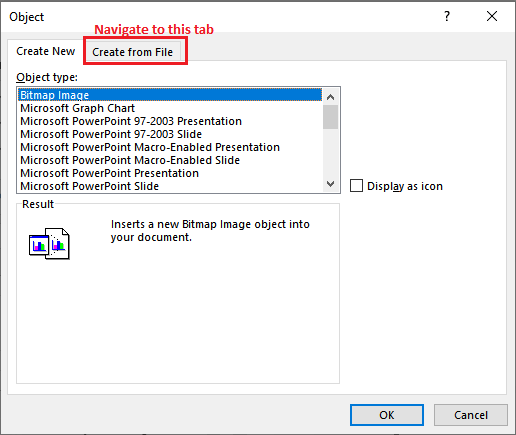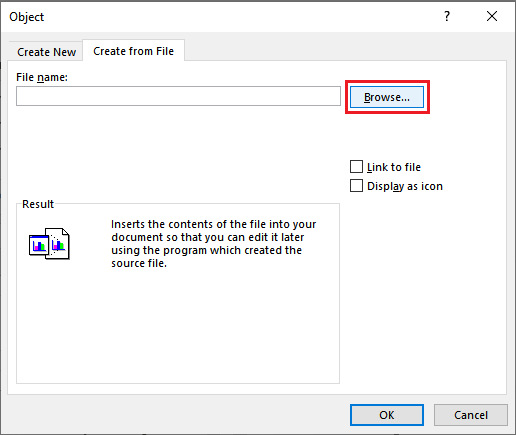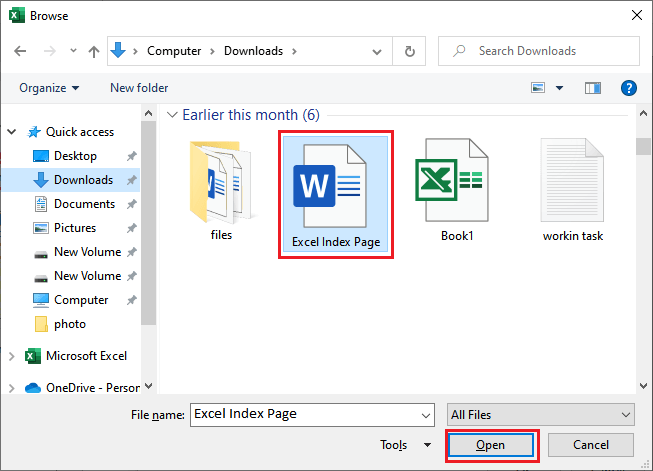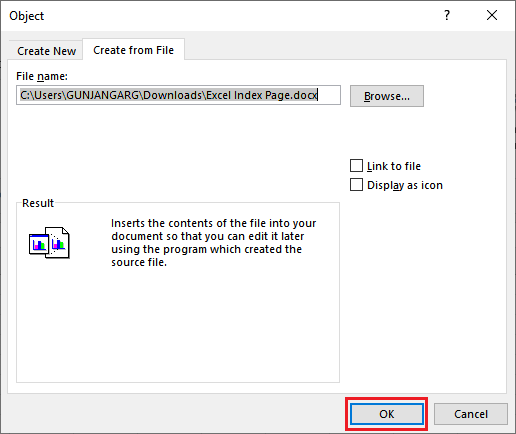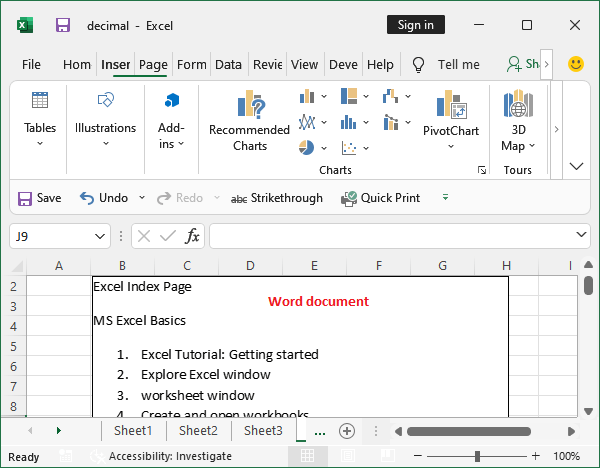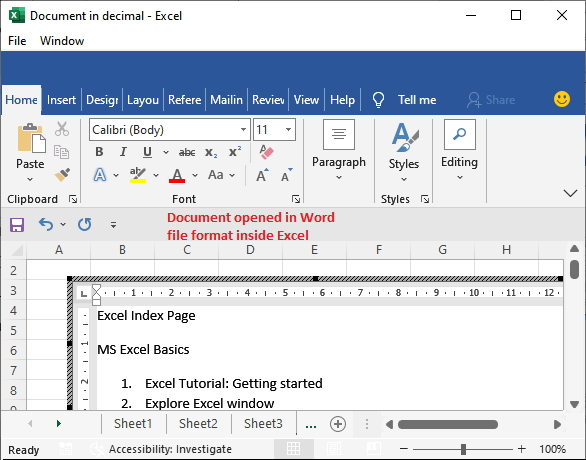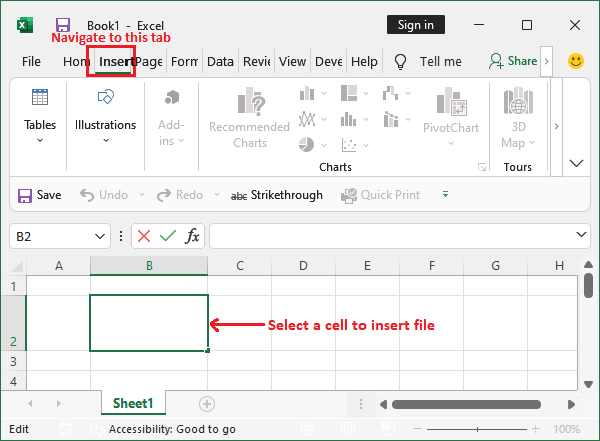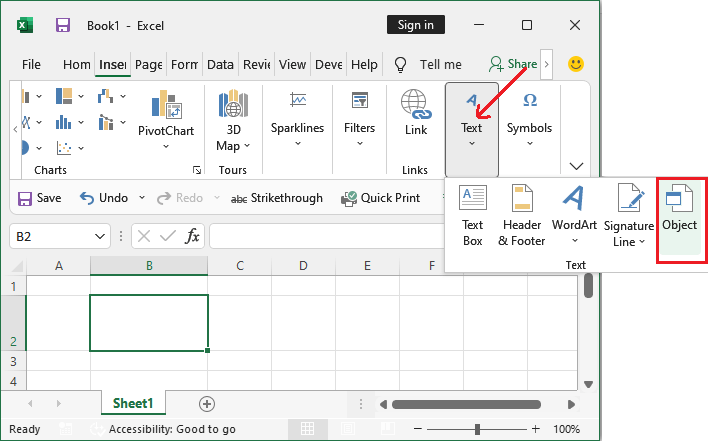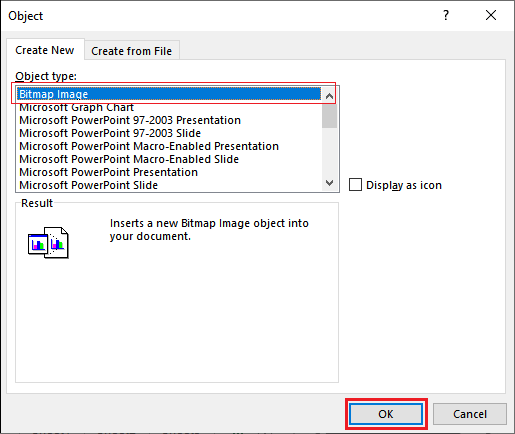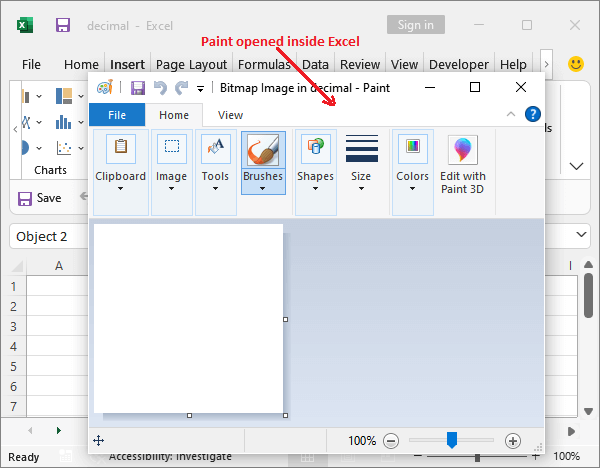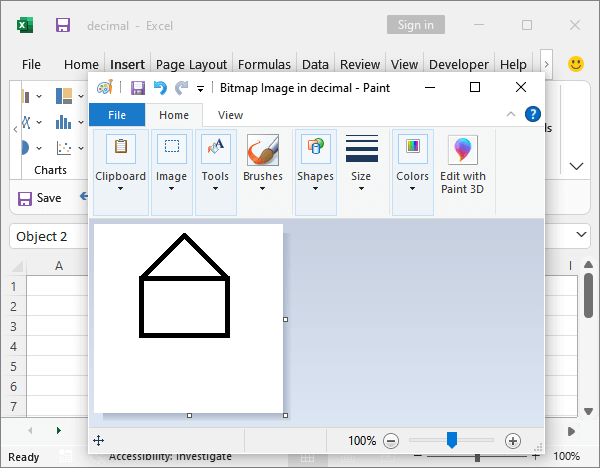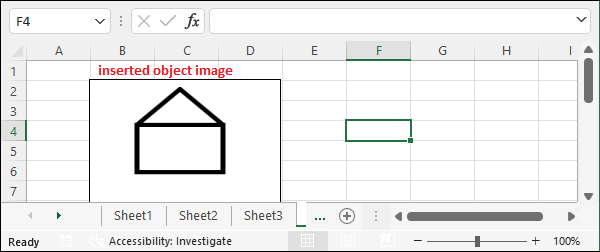You can use Object Linking and Embedding (OLE) to include content from other programs, such as Word or Excel.
OLE is supported by many different programs, and OLE is used to make content that is created in one program available in another program. For example, you can insert an Office Word document in an Office Excel workbook. To see what types of content that you can insert, click Object in the Text group on the Insert tab. Only programs that are installed on your computer and that support OLE objects appear in the Object type box.
If you copy information between Excel or any program that supports OLE, such as Word, you can copy the information as either a linked object or an embedded object. The main differences between linked objects and embedded objects are where the data is stored and how the object is updated after you place it in the destination file. Embedded objects are stored in the workbook that they are inserted in, and they are not updated. Linked objects remain as separate files, and they can be updated.
Linked and embedded objects in a document

1. An embedded object has no connection to the source file.
2. A linked object is linked to the source file.
3. The source file updates the linked object.
When to use linked objects
If you want the information in your destination file to be updated when the data in the source file changes, use linked objects.
With a linked object, the original information remains stored in the source file. The destination file displays a representation of the linked information but stores only the location of the original data (and the size if the object is an Excel chart object). The source file must remain available on your computer or network to maintain the link to the original data.
The linked information can be updated automatically if you change the original data in the source file. For example, if you select a paragraph in a Word document and then paste the paragraph as a linked object in an Excel workbook, the information can be updated in Excel if you change the information in your Word document.
When to use embedded objects
If you don’t want to update the copied data when it changes in the source file, use an embedded object. The version of the source is embedded entirely in the workbook. If you copy information as an embedded object, the destination file requires more disk space than if you link the information.
When a user opens the file on another computer, he can view the embedded object without having access to the original data. Because an embedded object has no links to the source file, the object is not updated if you change the original data. To change an embedded object, double-click the object to open and edit it in the source program. The source program (or another program capable of editing the object) must be installed on your computer.
Changing the way that an OLE object is displayed
You can display a linked object or embedded object in a workbook exactly as it appears in the source program or as an icon. If the workbook will be viewed online, and you don’t intend to print the workbook, you can display the object as an icon. This minimizes the amount of display space that the object occupies. Viewers who want to display the information can double-click the icon.
Embed an object in a worksheet
-
Click inside the cell of the spreadsheet where you want to insert the object.
-
On the Insert tab, in the Text group, click Object
.
-
In the Object dialog box, click the Create from File tab.
-
Click Browse, and select the file you want to insert.
-
If you want to insert an icon into the spreadsheet instead of show the contents of the file, select the Display as icon check box. If you don’t select any check boxes, Excel shows the first page of the file. In both cases, the complete file opens with a double click. Click OK.
Note: After you add the icon or file, you can drag and drop it anywhere on the worksheet. You can also resize the icon or file by using the resizing handles. To find the handles, click the file or icon one time.
Insert a link to a file
You might want to just add a link to the object rather than fully embedding it. You can do that if your workbook and the object you want to add are both stored on a SharePoint site, a shared network drive, or a similar location, and if the location of the files will remain the same. This is handy if the linked object undergoes changes because the link always opens the most up-to-date document.
Note: If you move the linked file to another location, the link won’t work anymore.
-
Click inside the cell of the spreadsheet where you want to insert the object.
-
On the Insert tab, in the Text group, click Object
.
-
Click the Create from File tab.
-
Click Browse, and then select the file you want to link.
-
Select the Link to file check box, and click OK.
Create a new object from inside Excel
You can create an entirely new object based on another program without leaving your workbook. For example, if you want to add a more detailed explanation to your chart or table, you can create an embedded document, such as a Word or PowerPoint file, in Excel. You can either set your object to be displayed right in a worksheet or add an icon that opens the file.
-
Click inside the cell of the spreadsheet where you want to insert the object.
-
On the Insert tab, in the Text group, click Object
.
-
On the Create New tab, select the type of object you want to insert from the list presented. If you want to insert an icon into the spreadsheet instead of the object itself, select the Display as icon check box.
-
Click OK. Depending on the type of file you are inserting, either a new program window opens or an editing window appears within Excel.
-
Create the new object you want to insert.
When you’re done, if Excel opened a new program window in which you created the object, you can work directly within it.
When you’re done with your work in the window, you can do other tasks without saving the embedded object. When you close the workbook your new objects will be saved automatically.
Note: After you add the object, you can drag and drop it anywhere on your Excel worksheet. You can also resize the object by using the resizing handles. To find the handles, click the object one time.
Embed an object in a worksheet
-
Click inside the cell of the spreadsheet where you want to insert the object.
-
On the Insert tab, in the Text group, click Object.
-
Click the Create from File tab.
-
Click Browse, and select the file you want to insert.
-
If you want to insert an icon into the spreadsheet instead of show the contents of the file, select the Display as icon check box. If you don’t select any check boxes, Excel shows the first page of the file. In both cases, the complete file opens with a double click. Click OK.
Note: After you add the icon or file, you can drag and drop it anywhere on the worksheet. You can also resize the icon or file by using the resizing handles. To find the handles, click the file or icon one time.
Insert a link to a file
You might want to just add a link to the object rather than fully embedding it. You can do that if your workbook and the object you want to add are both stored on a SharePoint site, a shared network drive, or a similar location, and if the location of the files will remain the same. This is handy if the linked object undergoes changes because the link always opens the most up-to-date document.
Note: If you move the linked file to another location, the link won’t work anymore.
-
Click inside the cell of the spreadsheet where you want to insert the object.
-
On the Insert tab, in the Text group, click Object.
-
Click the Create from File tab.
-
Click Browse, and then select the file you want to link.
-
Select the Link to file check box, and click OK.
Create a new object from inside Excel
You can create an entirely new object based on another program without leaving your workbook. For example, if you want to add a more detailed explanation to your chart or table, you can create an embedded document, such as a Word or PowerPoint file, in Excel. You can either set your object to be displayed right in a worksheet or add an icon that opens the file.
-
Click inside the cell of the spreadsheet where you want to insert the object.
-
On the Insert tab, in the Text group, click Object.
-
On the Create New tab, select the type of object you want to insert from the list presented. If you want to insert an icon into the spreadsheet instead of the object itself, select the Display as icon check box.
-
Click OK. Depending on the type of file you are inserting, either a new program window opens or an editing window appears within Excel.
-
Create the new object you want to insert.
When you’re done, if Excel opened a new program window in which you created the object, you can work directly within it.
When you’re done with your work in the window, you can do other tasks without saving the embedded object. When you close the workbook your new objects will be saved automatically.
Note: After you add the object, you can drag and drop it anywhere on your Excel worksheet. You can also resize the object by using the resizing handles. To find the handles, click the object one time.
Link or embed content from another program by using OLE
You can link or embed all or part of the content from another program.
Create a link to content from another program
-
Click in the worksheet where you want to place the linked object.
-
On the Insert tab, in the Text group, click Object.
-
Click the Create from File tab.
-
In the File name box, type the name of the file, or click Browse to select from a list.
-
Select the Link to file check box.
-
Do one of the following:
-
To display the content, clear the Display as icon check box.
-
To display an icon, select the Display as icon check box. Optionally, to change the default icon image or label, click Change Icon, and then click the icon that you want from the Icon list, or type a label in the Caption box.
Note: You cannot use the Object command to insert graphics and certain types of files. To insert a graphic or file, on the Insert tab, in the Illustrations group, click Picture.
-
Embed content from another program
-
Click in the worksheet where you want to place the embedded object.
-
On the Insert tab, in the Text group, click Object.
-
If the document does not already exist, click the Create New tab. In the Object type box, click the type of object that you want to create.
If the document already exists, click the Create from File tab. In the File name box, type the name of the file, or click Browse to select from a list.
-
Clear the Link to file check box.
-
Do one of the following:
-
To display the content, clear the Display as icon check box.
-
To display an icon, select the Display as icon check box. To change the default icon image or label, click Change Icon, and then click the icon that you want from the Icon list, or type a label in the Caption box.
-
Link or embed partial content from another program
-
From a program other than Excel, select the information that you want to copy as a linked or embedded object.
-
On the Home tab, in the Clipboard group, click Copy.
-
Switch to the worksheet that you want to place the information in, and then click where you want the information to appear.
-
On the Home tab, in the Clipboard group, click the arrow below Paste, and then click Paste Special.
-
Do one of the following:
-
To paste the information as a linked object, click Paste link.
-
To paste the information as an embedded object, click Paste. In the As box, click the entry with the word «object» in its name. For example, if you copied the information from a Word document, click Microsoft Word Document Object.
-
Change the way that an OLE object is displayed
-
Right-click the icon or object, point to object typeObject (for example, Document Object), and then click Convert.
-
Do one of the following:
-
To display the content, clear the Display as icon check box.
-
To display an icon, select the Display as icon check box. Optionally, you can change the default icon image or label. To do that, click Change Icon, and then click the icon that you want from the Icon list, or type a label in the Caption box.
-
Control updates to linked objects
You can set links to other programs to be updated in the following ways: automatically, when you open the destination file; manually, when you want to see the previous data before updating with the new data from the source file; or when you specifically request the update, regardless of whether automatic or manual updating is turned on.
Set a link to another program to be updated manually
-
On the Data tab, in the Connections group, click Edit Links.
Note: The Edit Links command is unavailable if your file does not contain links to other files.
-
In the Source list, click the linked object that you want to update. An A in the Update column means that the link is automatic, and an M in the Update column means that the link is set to Manual update.
Tip: To select multiple linked objects, hold down CTRL and click each linked object. To select all linked objects, press CTRL+A.
-
To update a linked object only when you click Update Values, click Manual.
Set a link to another program to be updated automatically
-
On the Data tab, in the Connections group, click Edit Links.
Note: The Edit Links command is unavailable if your file does not contain links to other files.
-
In the Source list, click the linked object that you want to update. An A in the Update column means that the link will update automatically, and an M in the Update column means that the link must be updated manually.
Tip: To select multiple linked objects, hold down CTRL and click each linked object. To select all linked objects, press CTRL+A.
-
Click OK.
Issue: I can’t update the automatic links on my worksheet
The Automatic option can be overridden by the Update links to other documents Excel option.
To ensure that automatic links to OLE objects can be automatically updated:
-
Click the Microsoft Office Button
, click Excel Options, and then click the Advanced category.
-
Under When calculating this workbook, make sure that the Update links to other documents check box is selected.
Update a link to another program now
-
On the Data tab, in the Connections group, click Edit Links.
Note: The Edit Links command is unavailable if your file does not contain linked information.
-
In the Source list, click the linked object that you want to update.
Tip: To select multiple linked objects, hold down CTRL and click each linked object. To select all linked objects, press CTRL+A.
-
Click Update Values.
Edit content from an OLE program
While you are in Excel, you can change the content linked or embedded from another program.
Edit a linked object in the source program
-
On the Data tab, in the Connections group, click Edit Links.
Note: The Edit Links command is unavailable if your file does not contain linked information.
-
In the Source file list, click the source for the linked object, and then click Open Source.
-
Make the changes that you want to the linked object.
-
Exit the source program to return to the destination file.
Edit an embedded object in the source program
-
Double-click the embedded object to open it.
-
Make the changes that you want to the object.
-
If you are editing the object in place within the open program, click anywhere outside of the object to return to the destination file.
If you edit the embedded object in the source program in a separate window, exit the source program to return to the destination file.
Note: Double-clicking certain embedded objects, such as video and sound clips, plays the object instead of opening a program. To edit one of these embedded objects, right-click the icon or object, point to object typeObject (for example, Media Clip Object), and then click Edit.
Edit an embedded object in a program other than the source program
-
Select the embedded object that you want to edit.
-
Right-click the icon or object, point to object typeObject (for example, Document Object), and then click Convert.
-
Do one of the following:
-
To convert the embedded object to the type that you specify in the list, click Convert to.
-
To open the embedded object as the type that you specify in the list without changing the embedded object type, click Activate.
-
Select an OLE object by using the keyboard
-
Press CTRL+G to display the Go To dialog box.
-
Click Special, select Objects, and then click OK.
-
Press TAB until the object that you want is selected.
-
Press SHIFT+F10.
-
Point to Object or Chart Object, and then click Edit.
Issue: When I double-click a linked or embedded object, a «cannot edit» message appears
This message appears when the source file or source program can’t be opened.
Make sure that the source program is available If the source program is not installed on your computer, convert the object to the file format of a program that you do have installed.
Ensure that memory is adequate Make sure that you have enough memory to run the source program. Close other programs to free up memory, if necessary.
Close all dialog boxes If the source program is running, make sure that it doesn’t have any open dialog boxes. Switch to the source program, and close any open dialog boxes.
Close the source file If the source file is a linked object, make sure that another user doesn’t have it open.
Ensure that the source file name has not changed If the source file that you want to edit is a linked object, make sure that it has the same name as it did when you created the link and that it has not been moved. Select the linked object, and then click the Edit Links command in the Connections group on the Data tab to see the name of the source file. If the source file has been renamed or moved, use the Change Source button in the Edit Links dialog box to locate the source file and reconnect the link.
Need more help?
You can always ask an expert in the Excel Tech Community or get support in the Answers community.
Skip to content
How to Insert Attachments in Excel?
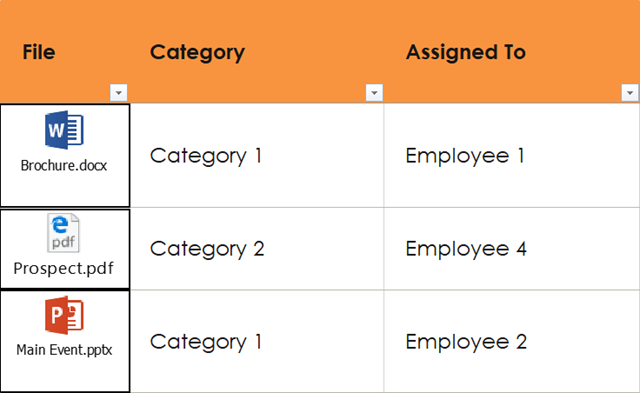
Do you ever need to insert files into Excel, so you can share more comprehensive information with your colleagues? Either to insert PDF into Excel or to insert word documents into Excel, it’s just as simple as clicking on Insert, Text, Object, choosing your file, and voila!
Then, what happens after? Your file will float around your spreadsheet and not into a single cell. Yet, to be able to sort or move it with the rest of the content, what you really need is to put it into a single cell. How can you do this?
In this brief article, we will see how Excel can better handle your attachments, then we will look into an alternative that integrates with Excel: RowShare, an online table that offers a collaboration solution.
Insert Files into Excel Sheet
There are several ways to insert files into Excel sheet. You can either create from files, create new or add link to files. We will explore how to do it one by one.
If you want to create from an existing file, follow these steps:
- Select the cell into which you want to insert your file
- Click on the “Insert” tab
- Click on “Object” under the “Text” group
- Select “Create from File”
- Browse your file
- Select the “Display as icon” check box to if you want to insert an icon linking to the files
- Click on “OK”
Another possibility is to create a new file. You can do that by selecting “Create New” instead, and choose the type of object you want to attach. A new window will then pop up and you can create a new file you want to insert.
If you only want to add a link to the file instead of embedding the file, select the “Link to File” check box. The file should be stored in a location accessible to those with whom you want to share it. If the link to your file redirects to your computer, you will be the only one able to open it. Other than that, the location of the file should remain the same, if you move it to different location, the link won’t work anymore.
Attach Files in Excel, Within Excel Cells
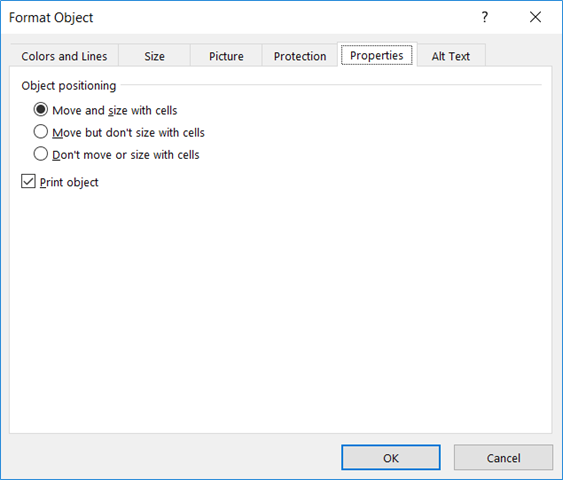
Once you have made it to insert word documents into Excel or attach PDF to Excel, you probably realize that what you need is to insert your file into a single cell. To do this, follow these steps:
- Resize your file or cell until they fit each other
- Right click on your file and select “Format Object”
- Click on the “Properties” tab
- Select “Move and size with cells”
Since your Excel file size will be the size of the sheet itself plus the size of each other files attached, your Excel size will then be so huge. Also, as you can see here, there is no direct way to insert your file to an Excel cell automatically.
So, crunch time: Should I follow all these long endless steps or should I stick to the traditional way and exchange my files using email instead?
Attach Files Easily with RowShare
It’s time to say goodbye to complicated spreadsheet and endless email exchange. RowShare, an online table focusing in sharing and collaboration, offers a simpler solution. You can insert attachments within a click of a mouse! Start by creating a table from RowShare’s templates or from scratch.
Attach your files by following these super simple steps:
- Add a column of type “File” to your table
- Click on the cell, browse your file and attach it to your RowShare table
You can also control your table and files the way you want it, from sorting, filtering, setting columns as read only, you name it. It couldn’t be any simpler, here is a quick video if you need help:
When it comes to collecting, centralizing and sharing data with your coworkers, partners, suppliers, clients, RowShare is a real time-saver !
Discover all the things you could do :
Tip: If you already have your table in Excel, import it to RowShare and change the appropriate column type to File. Then, click on the cell and upload the file.
Once you have finished adjusting your table in RowShare, you can then synchronize it with Excel to access the best features of both tools. When synchronizing with Excel, instead of having the file itself, you will have the link of the file in your Excel sheet.
Happy RowSharing!
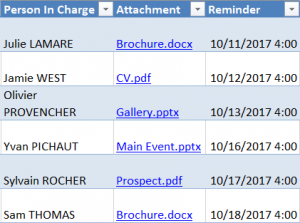

Collaborative, simple and reliable.
Rowshare is the first spreadsheet designed especially for managing projects and organizing administrative tasks.
Page load link
REJECT ALLACCEPT AND CONTINUE
Privacy Overview

Go to Top
This article will show you how to easily add/attach file like PDF, Word or any other to Excel spreadsheet.
Applies to: Excel, Excel 2013, Excel 2016, Excel 2019, Excel 365, Office 365
-
Go to Insert tab
Excel 2016/2019/365 — Home tab
-
Click Object button placed in Text group.
Narrow window
Insert Object button — narrow window
Medium width window
Insert Object button — medium width window
Maximum width window
Insert Object button — max width window
-
Click Create from file and browse for the file.
Click to enlarge
Содержание
- How to Insert an Attachment Into an Excel Spreadsheet
- Related
- Reasons to Attach a File
- Attachments Need to be on the Same Computer
- Attach an Existing File
- Create and Attach a New File
- How to attach file in excel
- Insert files into Excel sheet as an icon
- Insert files into Excel sheet as link
- Attachment should be on same computer
- Insert files into Excel sheet
- Create a new object from inside Excel
- Feedback
- Help Others, Please Share
- Learn Latest Tutorials
- Preparation
- Trending Technologies
- B.Tech / MCA
- Javatpoint Services
- Training For College Campus
How to Insert an Attachment Into an Excel Spreadsheet
When you insert files into an Excel ( file, such as a PDF file, Word document or an email message, you can access it more easily during a meeting or share more comprehensive information when you send the spreadsheet to a co-worker. When you attach an object this way, you can add all the content of an existing file, include a clickable icon linked to the file, or create a brand new file and then embed it in your Excel worksheet.
Reasons to Attach a File
You can insert Word documents into Excel files or attach just about any form of media. The process is easy and it serves multiple purposes. In many cases, inserting a file is a convenient means of consolidating relevant information into a single document.
For example, you might have a spreadsheet with sales contacts but you also have a Word document with extensive notes for certain individual contacts on the spreadsheet. You might also have PDF files with invoices and contracts relative to some contacts as well. Rather than creating a separate file for each contact or hosting this information separately, you can add an attachment for quick access.
Another common reason is to access exterior documents and elements for a presentation. While presenting, you can quickly retrieve other documents and elements for the presentation. These exterior elements will pop open and you can continue running the presentation seamlessly.
Attachments Need to be on the Same Computer
You can embed a PowerPoint presentation to bounce out of Excel after sharing data on a workbook. You can also attach files in Excel with other graphics. One thing to note is that the attachments will only retrieve if the file is hosted on the same computer or on a server that is available during the presentation.
If you use the Excel sheet on a different drive while presenting, make sure the exterior files are also hosted on the drive.
Attach an Existing File
Attaching the actual file is easy. Click inside the cell of the spreadsheet where you want to insert the object. Select the Insert tab. Click Object in the Text group to open the Object dialog box. Select the Create From File tab. Click the Browse button and locate the file you want to attach. Click the file to select it and click the Insert button.
At this point, you have the file ready but need to determine how you will access the file. Select the Link to File check box if you want to embed the contents of the file in the worksheet. Select the Create Icon check box to insert an icon that links to the file. Select OK to complete the process and attach the file.
Create and Attach a New File
Click inside the cell of the spreadsheet where you want to insert the object. Select the Insert tab then click Object in the text group to open the Object dialog box.
Click the Create New tab open a fresh file. Choose the type of object you want to attach from the Object Type box. Select the Create Icon check box to insert an icon that links to the file. Click OK to finalize and add the icon to the document.
Depending on the type of object you select, either a program window opens or an editing window appears within Excel. Create the new file you want to insert. Close the new program window or click back on the Excel window to attach the new file.
Save the spreadsheet before closing Excel. Your changes will not save permanently until you update the document.
Источник
How to attach file in excel
The Excel user may require to insert a file as an attachment to their Excel sheet. They can share more information with the help of file attachments. An excel user can insert any type of file in an Excel sheet. The users have to follow a few simple steps to do this.
When a file is attached, it floats over the spreadsheet instead of single cell you selected. There are several ways to insert any type of file into an Excel sheet as an attachment. The attachment file can be an image file, pdf, word, text, or any type of file.
This chapter of Excel file attachment will help you to learn to attach a file in MS Excel sheet.
Insert files into Excel sheet as an icon
There are several ways in Excel to insert a file into an Excel sheet. We will insert a file in the B2 cell of an Excel sheet.
Follow the steps to insert an existing file as an attachment into an Excel sheet:
Step 1: Select a cell where you need to insert an attachment file or image (anything you want). Then navigate to the Insert tab.
Step 2: Click the Object residing inside the Text group dropdown list at the end of the ribbon.
Step 3: A Object window panel will open where navigate to the Create from file tab.
Step 4: Here, click the Browse button to search the file in your local storage on your system for file attachment.
Step 5: Now, browse an existing file you want to insert and click Open button. We have selected a pdf file to insert.
Step 6: Mark the Display as icon checkbox if you want to insert the attachment as an icon that has link to this attachment file.
Click OK to make the process complete to insert an attachment as an icon.
You can also change the icon to be shown after attachment file into Excel sheet.
Step 7: You can see that a file has been inserted to Excel sheet as an icon.
Tip: You can resize the icon size.
Step 8: When you double-tap on this icon, a popup will open like this. Click Open on this popup window.
Step 9: The inserted file will be opened in the software which type of file is this. Our attachment file will open in a browser.
Insert files into Excel sheet as link
As you have learned in previous steps to insert a file as an icon into an Excel sheet. Now, we will show you the steps to insert a file attachment into the Excel file as a link. Follow the steps to insert an existing file as a link attachment into an Excel sheet:
Step 1: Select a cell where you need to insert an attachment file or image (anything you want). Then navigate to the Insert tab.
Step 2: Click the Object residing inside the Text group section at the end of the ribbon.
Step 3: A window panel will open where navigate to the Create from file tab.
Step 4: Here, click the Browse button to search the file in your local storage on your system for file attachment.
Step 5: Now, browse your existing file in your system and click the Insert button. We are inserting a video file as an attachment.
Step 6: This time, mark the Link to file checkbox to insert the attachment as a link instead of an icon or complete file view.
Click OK to make the process complete to insert an attachment as an icon.
Step 7: You can see that a video file has been inserted into the Excel sheet as a link to this file.
Tip: You can resize the link size. You can also see the file link along with the file type icon.
Step 8: When you click on this link of the file/image you attached, a popup will open like this. Click Open on this popup window.
The inserted video attachment file will open and play in the software which type of file is this. Our attachment file will open in a browser.
Attachment should be on same computer
You can attach different types of files in Excel whichever you need. You can insert a file with other graphics as well. The user must know that the file either should be available on the same computer or on a server that must be available while using file or during presentation.
In MS Excel, you can use object linking or embedding to attach the other format file into an Excel sheet. The file can be a word file, image file, or Excel file as well.
Insert files into Excel sheet
Instead of inserting a file that displays as link or as an icon, you can directly insert it into an Excel cell. This will completely visible in the file.
We have already explained the steps to insert a file that displays either as an icon or link into an Excel sheet. Now, we will show you the steps to insert a file attachment that will be directly visible in Excel sheet without clicking on any link or icon. Follow the steps to insert an existing file as a link attachment into an Excel sheet:
Step 1: Select a cell where you need to insert an attachment file or image (anything you want). Then navigate to the Insert tab.
Step 2: Click the Object residing inside the Text group section in the end of the ribbon.
Step 3: On the Create from file tab, select an object type you want to insert.
Step 4: Click the Browse button to look for the file in your local storage.
Step 5: Select a file from your system and click the Open button here. For this example, we have selected a word file.
Step 6: Without doing anything here, click OK to complete the process and insert an attachment as an icon.
Step 7: You can see that a file has been inserted into an Excel sheet that is completely visual in Excel without clicking any icon or link.
A word document has been inserted into an Excel sheet, which is currently uneditable.
Step 8: To make this inserted document editable inside Excel, double-tap on it. It will open in its supported format inside Excel, like below —
Now, you can edit anything inside the inserted document from here.
Create a new object from inside Excel
You can create an entirely new object based on another program without leaving your workbook. For example, if you want to add a more detailed explanation to your chart or table, you can create an embedded document in Excel, such as a Word or PowerPoint file or image file as well.
In MS Excel file, the user can either set your object to be displayed directly in a worksheet or also can add an icon that opens the file.
It allows the users to create an object type directly from Excel without leaving the Microsoft Excel screen. After that, created object will automatically insert into the file.
Step 1: Select a cell where you need to insert an attachment file or image (anything you want). Then navigate to the Insert tab.
Step 2: Click the Object residing inside the Text group section at the end of the ribbon.
Step 3: On the Create New tab, select an object type you want to insert. For example, we select
Step 4: A paint window will open inside the MS Excel where you can draw and edit any image.
Step 5: You can draw anything you need like we have designed the following image.
Step 6: The image is automatically inserted into this Excel file as an object.
You have now not to do anything. Just save your Excel file. If you want to edit the inserted object image, double-tap on the image to open up in paint directly from here.
Tip: Any image or file created through Excel object does not externally save on your system. It only keeps inside the MS Excel file in which you create it.
In this way, you can create word documents, graph charts, PowerPoint documents, and other docs you need.
Feedback


Learn Latest Tutorials
Python Design Patterns
Preparation
Trending Technologies
B.Tech / MCA
Javatpoint Services
JavaTpoint offers too many high quality services. Mail us on [email protected], to get more information about given services.
- Website Designing
- Website Development
- Java Development
- PHP Development
- WordPress
- Graphic Designing
- Logo
- Digital Marketing
- On Page and Off Page SEO
- PPC
- Content Development
- Corporate Training
- Classroom and Online Training
- Data Entry
Training For College Campus
JavaTpoint offers college campus training on Core Java, Advance Java, .Net, Android, Hadoop, PHP, Web Technology and Python. Please mail your requirement at [email protected]
Duration: 1 week to 2 week
Источник
When you insert files into an Excel ( file, such as a PDF file, Word document or an email message, you can access it more easily during a meeting or share more comprehensive information when you send the spreadsheet to a co-worker. When you attach an object this way, you can add all the content of an existing file, include a clickable icon linked to the file, or create a brand new file and then embed it in your Excel worksheet.
Reasons to Attach a File
You can insert Word documents into Excel files or attach just about any form of media. The process is easy and it serves multiple purposes. In many cases, inserting a file is a convenient means of consolidating relevant information into a single document.
For example, you might have a spreadsheet with sales contacts but you also have a Word document with extensive notes for certain individual contacts on the spreadsheet. You might also have PDF files with invoices and contracts relative to some contacts as well. Rather than creating a separate file for each contact or hosting this information separately, you can add an attachment for quick access.
Another common reason is to access exterior documents and elements for a presentation. While presenting, you can quickly retrieve other documents and elements for the presentation. These exterior elements will pop open and you can continue running the presentation seamlessly.
Attachments Need to be on the Same Computer
You can embed a PowerPoint presentation to bounce out of Excel after sharing data on a workbook. You can also attach files in Excel with other graphics. One thing to note is that the attachments will only retrieve if the file is hosted on the same computer or on a server that is available during the presentation.
If you use the Excel sheet on a different drive while presenting, make sure the exterior files are also hosted on the drive.
Attach an Existing File
Attaching the actual file is easy. Click inside the cell of the spreadsheet where you want to insert the object. Select the Insert tab. Click Object in the Text group to open the Object dialog box. Select the Create From File tab. Click the Browse button and locate the file you want to attach. Click the file to select it and click the Insert button.
At this point, you have the file ready but need to determine how you will access the file. Select the Link to File check box if you want to embed the contents of the file in the worksheet. Select the Create Icon check box to insert an icon that links to the file. Select OK to complete the process and attach the file.
Create and Attach a New File
Click inside the cell of the spreadsheet where you want to insert the object. Select the Insert tab then click Object in the text group to open the Object dialog box.
Click the Create New tab open a fresh file. Choose the type of object you want to attach from the Object Type box. Select the Create Icon check box to insert an icon that links to the file. Click OK to finalize and add the icon to the document.
Depending on the type of object you select, either a program window opens or an editing window appears within Excel. Create the new file you want to insert. Close the new program window or click back on the Excel window to attach the new file.
Save the spreadsheet before closing Excel. Your changes will not save permanently until you update the document.

 .
.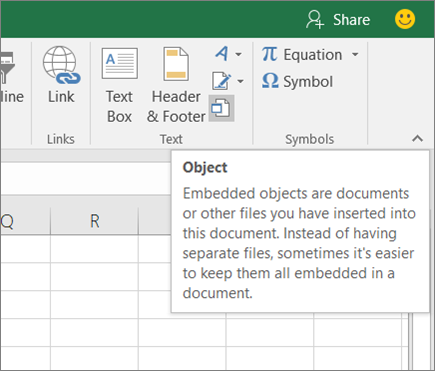


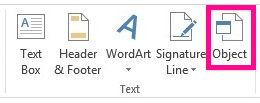
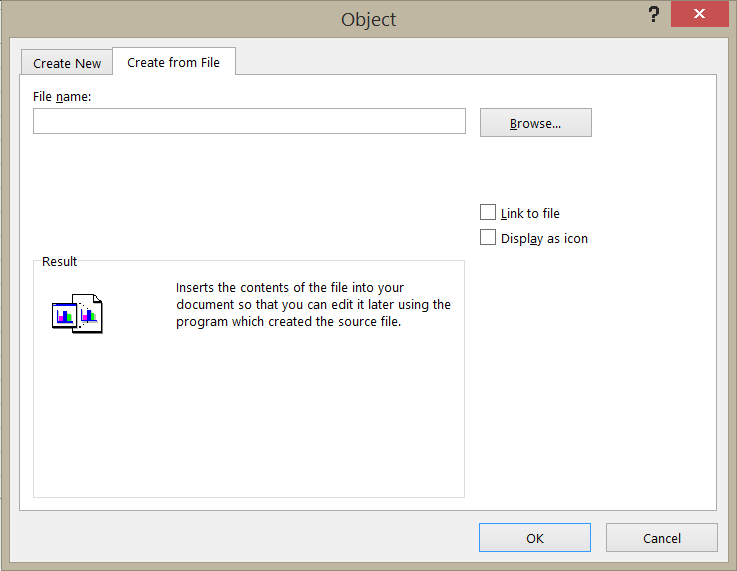
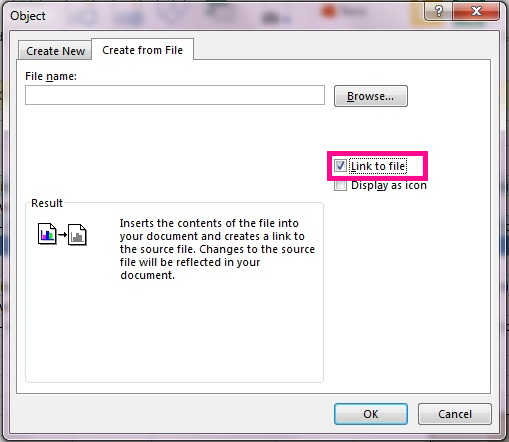
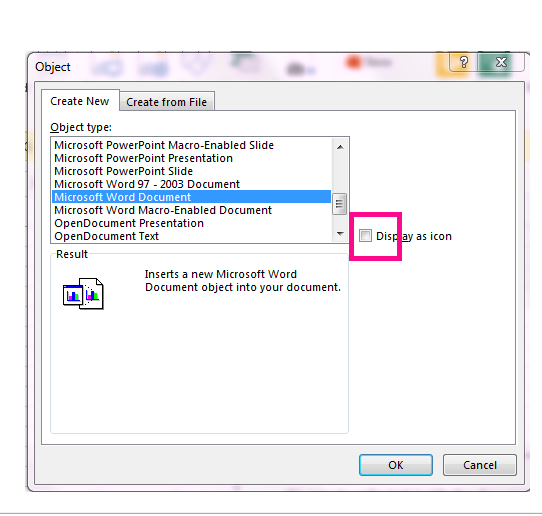



 , click Excel Options, and then click the Advanced category.
, click Excel Options, and then click the Advanced category.